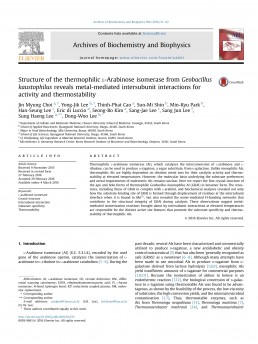Click the link above for more details.
Structure of the thermophilic L-Arabinose isomerase from Geobacillus kaustophilus reveals metal-mediated intersubunit interactions for activity and thermostability
Abstract
Thermophilic L-arabinose isomerase (AI), which catalyzes the interconversion of L-arabinose and L-ribulose, can be used to produce D-tagatose, a sugar substitute, from D-galactose. Unlike mesophilic AIs, thermophilic AIs are highly dependent on divalent metal ions for their catalytic activity and thermostability at elevated temperatures. However, the molecular basis underlying the substrate preferences and metal requirements of multimeric AIs remains unclear. Here we report the first crystal structure of the apo and holo forms of thermophilic Geobacillus kaustophilus AI (GKAI) in hexamer form. The structures, including those of GKAI in complex with L-arabitol, and biochemical analyses revealed not only how the substrate-binding site of GKAI is formed through displacement of residues at the intersubunit interface when it is bound to Mn2þ, but also revealed the water-mediated H-bonding networks that contribute to the structural integrity of GKAI during catalysis. These observations suggest metalmediated isomerization reactions brought about by intersubunit interactions at elevated temperatures are responsible for the distinct active site features that promote the substrate specificity and thermostability of thermophilic AIs.
CategoryPeer-reviewed PublicationsDate2016.03Linkwww.ncbi.nlm.nih.gov
